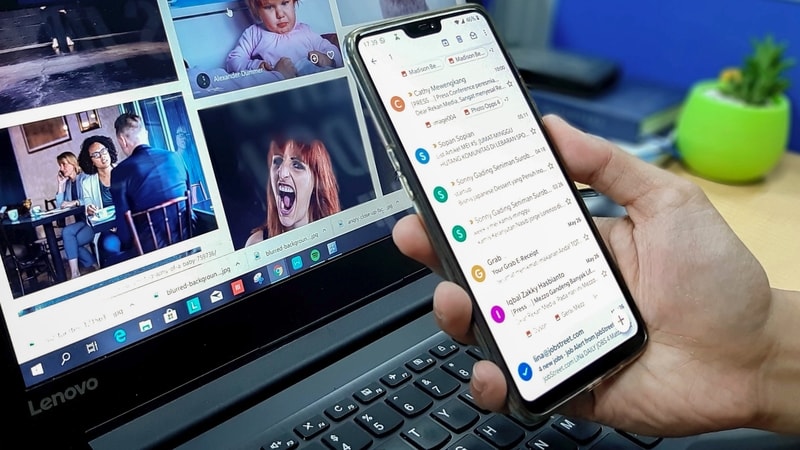Table of Contents
If you don’t already see the value in email marketing for your business, you should see it after reading this article. First, let’s consider a couple of notable points about email and why it’s an effective marketing tool. More than half of the global population uses email. That’s around 3.9 billion people including the approximately 233 million in the U.S. To put this into perspective, there are 3.5 billion social media users worldwide. This is an impressive figure but it’s still less than the number of email users. By 2023, it’s estimated that the number of email users worldwide will exceed 4.3 billion. There’s no questioning email’s popularity.
As a business owner, you can use email marketing to reach potential customers. In fact, 59% of consumers say their purchase decisions are influenced by email marketing. Email is a powerful way to connect with people.
In this article, we’ll discuss how to build a contact list, content basics, email design, how to send emails, and analytics. If you’re ready to use email to take your business to the next level, keep reading.

When creating a contact list, it’s important that you use opt-in or permission-based forms of email marketing. Both of these terms mean that your email recipients gave you permission to email them. The implementation of the EU General Data Protection Regulation (GDPR), makes following the rules regarding your email recipients’ data privacy more critical than ever.
There are a number of ways to give permission including filling out a form on your website or being an active customer. The key factor is that you, and not another company, were given permission to send them specific types of emails.
It’s also important to regularly weed out unresponsive recipients from your contact list. There’s no benefit to having a large number of potential email recipients if a considerable amount of them are ignoring your emails. Keeping your list “lean and mean” also ensures successful delivery.
To build a contact list that will give you a healthy start to your email marketing campaign, here are some recommendations. The goal is to build a list of subscribers (i.e. people who gave you permission) to your emails.
Successful delivery of your emails depends on how “lean and mean” your contact list is. If your list contains spamtraps (invalid email addresses used to identify spammers) or defunct email addresses that haven’t been used in a while, some internet service providers (ISPs) such as Gmail may send your emails to recipients’ spam folder.

The most common permission-based method of growing your contact list is to add a signup form to your website. Although the form can be added to any page on your website, placing it in an easy-to-spot location like your website’s homepage is recommended. But don’t stop there; share your signup form’s URL wherever you can, including on social media.
If you’re communicating with potential subscribers in person (i.e. at a trade show or conference), be prepared with signup sheets to hand out. Ask people for their email addresses and other pertinent information.
Many business owners ask for more than the email address. Depending on the type of business and email marketing goals, information such as name, city, and state may be requested. For example, a touring band may need this information whereas an online business may not. Do you want to send an automated email to customers on their birthdays? If yes, you should request a birth date on your signup form.
To get more people to complete your signup form, don’t ask for more information than you’ll need. A simple signup form is less daunting and less time-consuming to potential subscribers.

When contemplating what content to share with your subscribers, keep your goals in mind. You want to connect with your customers and fans by providing information that they value. You may also want to entertain them and give them something inspiring to look forward to. Whatever you decide to share with customers or potential customers, it should make them want to read your next email. It should make them want to share it with friends and to remain loyal customers.
What types of emails do you look forward to receiving in your inbox? Might your customers find the same thing interesting? Is there information you can share that your customers might be interested in knowing?
The topics that you cover in your emails can range from personal anecdotes, to detailed information about a product, to news related to the industry you’re in. If you’re imparting knowledge that’s of value to your customers and that holds their interest, your emails won’t feel like ads.
For instance, if you sell specialty teas, you could send regular emails to customers that provide information on the various health benefits of drinking tea. The emails could also contain information about the different ways to steep tea and which method is best for the most flavorful cup of tea. A true tea lover would find this interesting and may be inspired to try out some of your products.
To be respectful of customers’ time and increase the odds that they’ll read your entire email, be concise. A busy subscriber should be able to quickly scan your email to get the gist of your message.
If you want to go into depth on a particular topic, consider providing a synopsis in your email and then linking to the entire article on your website or blog. After all, that’s one of the goals of email marketing – to drive traffic to your site.
If the email you’re sending has a lot of valuable information, organizing it into sections and including a clickable table of contents is highly recommended. This practice is sometimes referred to as creating named anchors.
A CTA is a request that your email readers do something specific or take your desired action. Marketing emails are based on a main call-to-action, whether it be clicking through to your website to read the entire article, buying a product, or checking out your calendar of events.
Once you’ve established your main CTA, make it clear to subscribers what action you want them to take. You can effectively do this during the email design process by:
If readers need to scroll to read the end of your email, reiterate your CTA at the bottom of your message.
As in all written communication, good writing matters in email marketing. You don’t want to distract your readers with typos or improper use of punctuation. Is it really necessary to use ten exclamation marks? Before you hit the “send” button, here are three things to consider:
After you’ve written your email, always have someone with a sharp eye proofread it. They can catch things like passive sentences and poor grammar.

Take a cue from major blogs and publications and include a main title, article heading, possibly some teaser text (subheading), and then the body of your message. You should also add an image for visual interest. This layout will give your emails structure and make them easy to read.
However you decide to design your emails, use a format that is not only attractive but that doesn’t detract from your message. Keep it simple so that readers can easily digest the information.
A banner image is a logo or image that’s placed right at the top of your email. It’s similar to what you’ll find at the top of most websites. Your banner image serves the purpose of branding your email and because it’s one of the first things readers see, it’s important that it be attractive.
To create a banner image, use an image-editing application (online or desktop) such as Canva or get help from a graphic designer or a friend with design skills. Import your logo into the image-editing application and do any necessary cropping and resizing to make it fit your email. You don’t need to create an elaborate design. Your company name should suffice.
Using only images can result in beautiful and effective email banners. If you have a traditional brick-and-mortar store, consider using an image of your store with your store name as part of the image. The importance of a banner image can’t be stressed enough. It represents your business’ brand. Even if it’s something as simple as your business name in bold block letters, include a banner image.
Color plays an important role in the design of your email as it sets the tone or vibe. Whether you’re looking to set a calming mood with shades of blue or gray or going for a party vibe with neon or black, color matters.
A polished, intentional color scheme pulls everything together and helps to emphasize important points and links. A Google search will show that there are a ton of ready-made color schemes to choose from, but many business owners like to create their own unique schemes. Let your website and email banner image provide inspiration and guidance for your color scheme.
A color-picking tool like WebFX will help you to pull exact colors from your website or banner image and will provide you with the hexadecimal color code which is a six-character code made up of numbers and letters. All you have to do is hover the color picker over a color on your website or in your banner image and you’ll receive the “hex” code. You can then use that same color in your custom email color scheme.
Tips for creating a great color scheme:
When it comes to designing your emails, fonts (typography) are important to the overall look. For example, if you use a playful font like Comic Sans to share information of a more serious nature, your readers may be taken aback. You want to choose a font that sets the right mood for your message. Although the wrong font selection won’t be as distasteful as an inappropriate color scheme, it will dilute your message.
To be taken seriously, you want to ensure that you choose an appropriate font and font size for your message. When you’re not sure which direction to go in, err on the safe side and select a simple font like Helvetica or Arial. Your font should also be easy to read.
There’s no questioning the importance of images in your emails. Images can be used to break up large chunks of text and add visual interest to your emails. If you’re the owner of an online store, you can include thumbnail images of your newest products. If you’re promoting your local band, you can include images from your most recent performance. Restaurant owners can give readers a “visual taste” of their culinary creations.
Images provide a way to engage your readers without using words. The good news is that you don’t have to hire a photographer or designer or pay for images. There is an abundance of free stock photo sites. If you’re a photography buff, you can also take your own photos.
Here are a few suggestions when using images in your emails:

What’s the point of going through the effort to create captivating and engaging emails that no one is going to open? One way to get recipients to open your emails is to draw them in with attention-grabbing subject lines.
Unlike with social media, it doesn’t matter what day or time of day you send your emails. To get more people to open your emails, focus instead on writing compelling subject lines. There’s no such thing as a perfect subject line but you can take steps to ensure that it’s the best you can get it.
A compelling subject line must deliver on its promise of engaging and useful information. Make sure your email content follows through on the promise. If you want to increase your email open rates, write content that encourages great subject lines.
Here are some suggestions for writing excellent subject lines:
Writing subject lines is another area where it’s helpful to get feedback or constructive criticism from others. Ask your friends and associates to read your subject line and tell you if they think it captures the essence of your email message. Or, you could ask them to write the subject line that they feel best captures what your email is about. This may give you options that you wouldn’t have thought of on your own.
Personalization is essential to marketing practices because people want to be seen as individuals. Here are some facts concerning personalized marketing emails:
On average, personalized email messages perform three times better than the generic batch versions. Not surprising.
Thanks to marketing tools, personalizing email campaigns can be as simple as using email list segmentation along with personalization tags to add your customers’ names, certain events like their birthday, or information about their specific interests. This will make your customers feel special and may make them more loyal to your business.
Before hitting the send button, think about the name that will appear under the “From” column in your readers’ inboxes. Don’t make them wonder who the email is from. Let them know it’s from you.
For starters, don’t send your emails from an address like “[email protected]”. This is such an impersonal way to communicate with customers and potential customers. An email address like this can be off-putting because it doesn’t allow for replying to a real person. This automated practice makes it feel like they’re communicating with a computer.
Do your very best to send emails to your readers from you. That’s the best way to make connections. If the emails can show as coming from your personal email (i.e. [email protected]) this is even better than using an email address like “[email protected]”.
What name should you use? Your full name is a good place to start but what if many of your customers don’t know your full name? The best route to take is to use your name along with your company name (i.e. Carol at Walkers Clocks). In this way, you add the personal touch by including your name and legitimacy by showing that you represent a real company.
In order to measure the success of your email campaigns, you need to use email analytics. What is email analytics? Email analytics is a method of tracking the way subscribers interact with your email campaigns. You can gather and analyze data for each email campaign. You’ll then know if you’re reaching your goal of connecting with your customers. After all, that’s what email marketing is all about.
It can be satisfying to review the statistics of your campaigns and see the number or percentage of readers that opened your emails, clicked through to your website, and made a purchase. These stats can help you learn more about your customers and readers. If a particular theme or subject line consistently gets a lot of activity, you know to create similar content in future emails.
Because stats can be misleading as well as beneficial, it’s important to understand the basic metrics measured by email analytics. Email analytics stats generally measure:
Your views or open rate demonstrates how many people opened your email from the number of emails delivered. Keep in mind that when a reader sees your email in his or her inbox and clicks on it, the images need to load before it gets counted as a view. This is another reason to avoid using very large images that load slowly and may cause the reader to close the email before it loads completely. However, there are email clients like Yahoo and Google that don’t load images automatically unless the sender is in the reader’s address book or marked as a trusted sender.
Your email open rates will depend on several factors including how you collected information for your contact list, list age, sending frequency, industry, subject lines and the relationship you have with your readers. The average open rate for all industries is 21.33% so if only around one-fifth of recipients opens your email, you shouldn’t worry. However, if you find that less than 10% of recipients are reading your emails, you’ve got work to do.
One way to encourage more opens is to create intriguing subject lines that are relevant to the content of the email.
The click-through rate indicates how many people clicked on a link in your email. Click-through rates tend to be quite a bit lower than views. However, the rate can be increased by creating content that speaks to your subscribers’ interests. By combining educational and promotional content, you can encourage more visits to your website.
Some email marketers feel that click-through rate is the most important metric. However, the open rate is more indicative of your ability to inspire readers enough to open the email to see what you have to say. It shows how engaged readers are with your brand in general.
Although the open rate reveals how effective you are in encouraging readers to open your email, click-through rates can reflect whether you’re using links effectively. If you make it easy for readers to click through to your website, most will. You can accomplish this by making all of your images, including the banner, clickable and by placing text links throughout your content.
The unsubscribe rate shows how many subscribers clicked the “unsubscribe link” (usually found at the bottom of the email) to opt-out of receiving your emails. This doesn’t mean they have anything against you or your company. They simply aren’t interested in receiving your emails anymore.
Since the average unsubscribe rate is between .01% and .02%, you should be concerned if more than .02% of your subscribers consistently opt-out of receiving your emails. It may mean that you need to review the health of your contact list and/or the quality of the content you’re sharing.
The number of unsubscribes shouldn’t be a noticeable trend. If you respect your readers’ time by not sending too frequently and are providing valuable content, you shouldn’t see many unsubscribes.
You can use email analytics to keep your contact list up-to-date. If you consistently share content with your list, at around the six-month mark, you’ll likely see that 25% or more have viewed at least one of the emails you’ve sent.
This 25% of readers represent your fans and you should let them know how much you appreciate their loyalty. On the other hand, if there are people on your contact list who never viewed an email in the six-month period, it’s unlikely they’ll be interested in reading future emails.
Separate them from your main contact list and send them an email requesting that they opt-in again. Remind them why they signed up to receive your emails in the first place. If this tactic is unsuccessful, remove their email addresses from your list. By doing so, you’ll keep your list healthy and up-to-date.

Let’s recap the five basic components of email marketing:
These five components of effective email marketing should get you off to a great start. While you won’t be able to reach everyone every time, if you consistently send, you’ll reach most of your intended audience. Just be patient and keep improving where necessary.
With locations in every city, you'll have no problem finding the right loan.
View All Locations